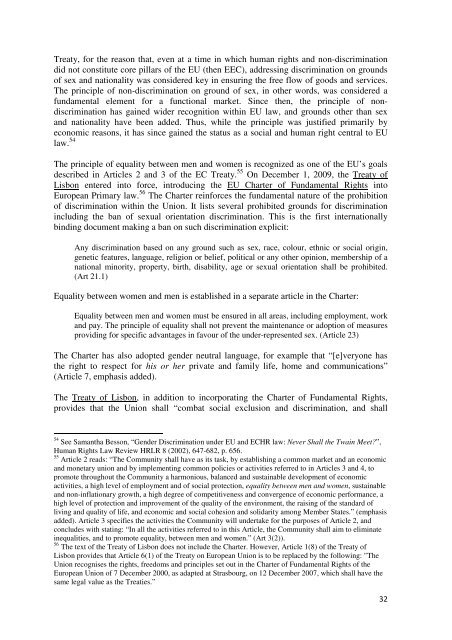Johanna Westeson - The ICHRP
Johanna Westeson - The ICHRP
Johanna Westeson - The ICHRP
Create successful ePaper yourself
Turn your PDF publications into a flip-book with our unique Google optimized e-Paper software.
Treaty, for the reason that, even at a time in which human rights and non-discrimination<br />
did not constitute core pillars of the EU (then EEC), addressing discrimination on grounds<br />
of sex and nationality was considered key in ensuring the free flow of goods and services.<br />
<strong>The</strong> principle of non-discrimination on ground of sex, in other words, was considered a<br />
fundamental element for a functional market. Since then, the principle of nondiscrimination<br />
has gained wider recognition within EU law, and grounds other than sex<br />
and nationality have been added. Thus, while the principle was justified primarily by<br />
economic reasons, it has since gained the status as a social and human right central to EU<br />
law. 54<br />
<strong>The</strong> principle of equality between men and women is recognized as one of the EU’s goals<br />
described in Articles 2 and 3 of the EC Treaty. 55 On December 1, 2009, the Treaty of<br />
Lisbon entered into force, introducing the EU Charter of Fundamental Rights into<br />
European Primary law. 56 <strong>The</strong> Charter reinforces the fundamental nature of the prohibition<br />
of discrimination within the Union. It lists several prohibited grounds for discrimination<br />
including the ban of sexual orientation discrimination. This is the first internationally<br />
binding document making a ban on such discrimination explicit:<br />
Any discrimination based on any ground such as sex, race, colour, ethnic or social origin,<br />
genetic features, language, religion or belief, political or any other opinion, membership of a<br />
national minority, property, birth, disability, age or sexual orientation shall be prohibited.<br />
(Art 21.1)<br />
Equality between women and men is established in a separate article in the Charter:<br />
Equality between men and women must be ensured in all areas, including employment, work<br />
and pay. <strong>The</strong> principle of equality shall not prevent the maintenance or adoption of measures<br />
providing for specific advantages in favour of the under-represented sex. (Article 23)<br />
<strong>The</strong> Charter has also adopted gender neutral language, for example that “[e]veryone has<br />
the right to respect for his or her private and family life, home and communications”<br />
(Article 7, emphasis added).<br />
<strong>The</strong> Treaty of Lisbon, in addition to incorporating the Charter of Fundamental Rights,<br />
provides that the Union shall “combat social exclusion and discrimination, and shall<br />
54 See Samantha Besson, “Gender Discrimination under EU and ECHR law: Never Shall the Twain Meet?”,<br />
Human Rights Law Review HRLR 8 (2002), 647-682, p. 656.<br />
55 Article 2 reads: “<strong>The</strong> Community shall have as its task, by establishing a common market and an economic<br />
and monetary union and by implementing common policies or activities referred to in Articles 3 and 4, to<br />
promote throughout the Community a harmonious, balanced and sustainable development of economic<br />
activities, a high level of employment and of social protection, equality between men and women, sustainable<br />
and non-inflationary growth, a high degree of competitiveness and convergence of economic performance, a<br />
high level of protection and improvement of the quality of the environment, the raising of the standard of<br />
living and quality of life, and economic and social cohesion and solidarity among Member States.” (emphasis<br />
added). Article 3 specifies the activities the Community will undertake for the purposes of Article 2, and<br />
concludes with stating: “In all the activities referred to in this Article, the Community shall aim to eliminate<br />
inequalities, and to promote equality, between men and women.” (Art 3(2)).<br />
56<br />
<strong>The</strong> text of the Treaty of Lisbon does not include the Charter. However, Article 1(8) of the Treaty of<br />
Lisbon provides that Article 6(1) of the Treaty on European Union is to be replaced by the following: "<strong>The</strong><br />
Union recognises the rights, freedoms and principles set out in the Charter of Fundamental Rights of the<br />
European Union of 7 December 2000, as adapted at Strasbourg, on 12 December 2007, which shall have the<br />
same legal value as the Treaties.”<br />
32
















